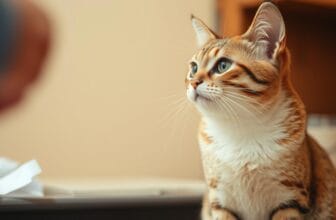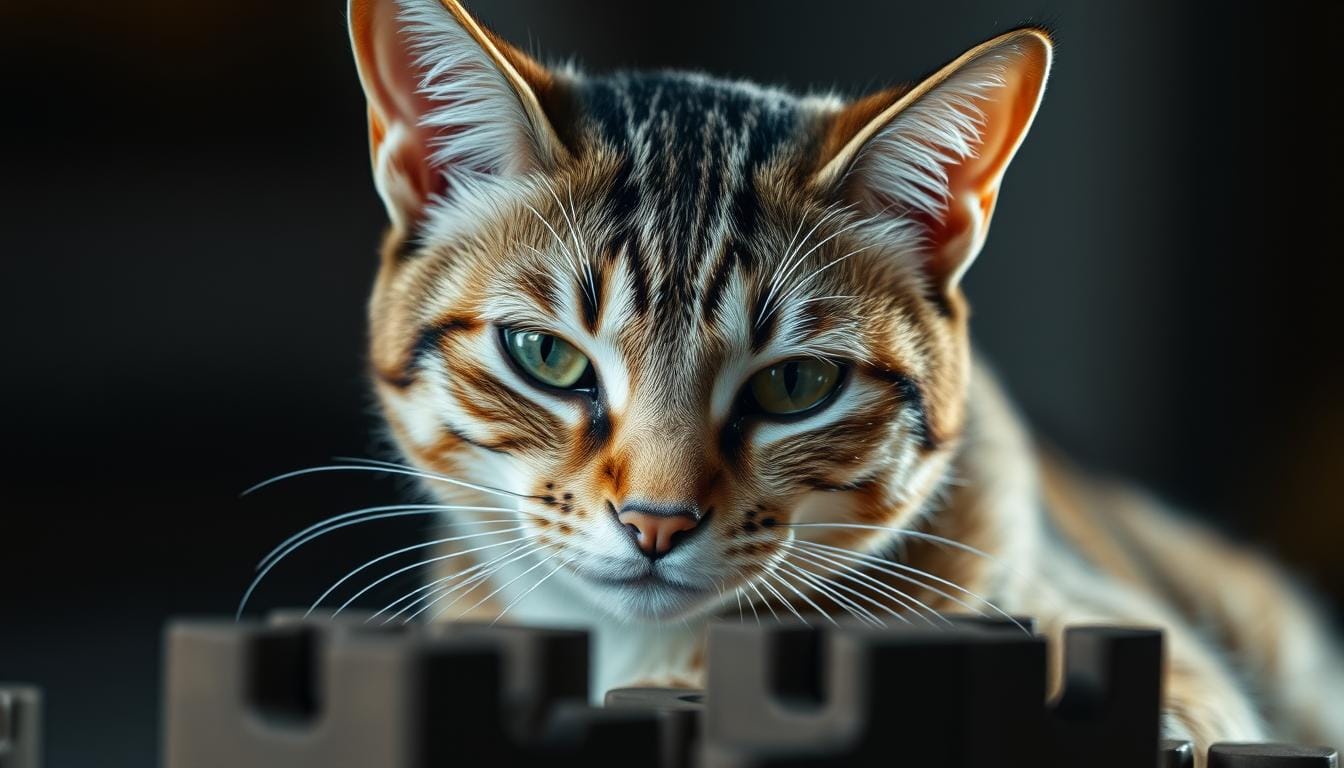
Table of Contents
Ever wonder what’s going on in your cat’s mind when they face a puzzle? Cats are smarter than they look, with brains that fire up to 300 million neurons. They solve problems in amazing ways, fascinating both scientists and cat lovers.
Cats’ brains are built for complex tasks. They learn fast and find new ways to solve problems. Knowing how cats think can help you keep their minds sharp and happy.
Studies show cats are quick learners and can adapt easily. They use observation, trial and error, and instinct to solve problems. This skill lets them find creative solutions to challenges.
Exploring cat intelligence shows how they tackle challenges. From solving food puzzles to defending their territory, cats amaze us with their smarts. They show us the power of their minds in surprising and delightful ways.
Understanding Feline Cognitive Abilities
Your cat’s brain is a fascinating marvel of nature. It’s packed with incredible cognitive potential. Feline cognitive abilities go far beyond simple instincts. They reveal a complex world of intelligence that surprises researchers and pet owners alike.
Cats have remarkable neural capabilities that set them apart in the animal kingdom. Their cat brain structure is surprisingly sophisticated. With approximately 300 million neurons, they can solve problems and learn in complex ways.
Neural Complexity and Brain Structure
The intricate cat brain structure shows remarkable similarities to human brains. Researchers have found that feline brains are about 90 percent similar to human brains in surface folding and neural organization.
- 300 million neurons supporting advanced cognitive functions
- Complex neural networks enabling sophisticated thinking
- Brain structure comparable to a 2-year-old human child
Memory and Learning Prowess
Cat memory capabilities are truly impressive. Their ability to remember and learn from past experiences lets them navigate complex environments. They solve intricate challenges with remarkable precision.
Comparative Intelligence
When comparing feline cognitive abilities to other animals, cats show exceptional intelligence. They outperform dogs in neuron count. They also have unique problem-solving skills that highlight their remarkable mental agility.
“Cats are not just pets; they are intelligent beings with complex cognitive landscapes.” – Feline Neuroscience Research Institute
Understanding your cat’s cognitive potential can help you provide better mental stimulation. It lets you appreciate their incredible intellectual capabilities.
The Science Behind Cat Problem Solving
Studies on cat intelligence have uncovered interesting facts about their problem-solving abilities. Researchers have worked hard to understand how cats tackle complex challenges. Contrary to common beliefs, cats have impressive cognitive skills that are more than just instinct.
Scientists have created special experiments to study cat problem-solving. These studies look into several important areas:
- Object permanence recognition
- Spatial reasoning capabilities
- Memory retention and learning patterns
- Adaptive problem-solving techniques
One key area of research is how cats deal with invisible objects. Object permanence shows that cats know objects still exist even when they can’t see them. This skill is vital for survival in both home and wild settings.
| Research Focus | Key Findings |
|---|---|
| Object Permanence | Cats can track hidden objects and predict their potential locations |
| Spatial Reasoning | Advanced ability to navigate complex environments |
| Memory Capacity | Can remember solution strategies for extended periods |
Studying cat cognition requires special research methods. Unlike dogs, cats are harder to study because of their independent nature. Researchers must design detailed experiments that show off their complex problem-solving skills while keeping the cats curious and engaged.
Cats demonstrate remarkable cognitive flexibility that continues to surprise scientists studying feline intelligence.
How Cats Learn Through Observation
Cats have amazing skills to watch and learn from their world. They use these skills to understand and adapt to their surroundings. This makes them very smart and able to learn in unique ways.
Your cat learns a lot from what it sees around it. Unlike other animals, cats learn by watching and trying things out. This helps them adapt to their environment in clever ways.
Social Learning Patterns
Cats are great at watching and learning from others. They pick up new skills from:
- Other cats in their household
- Human family members
- Interactions with their environment
“Cats learn not just by instinct, but through careful observation and intelligent interaction.” – Dr. Sarah Peterson, Feline Behavior Specialist
Environmental Adaptation Techniques
Your cat’s ability to adapt comes from its curiosity and problem-solving. Environmental adaptation lets cats quickly figure out and change their surroundings.
- Opening doors by watching human movements
- Figuring out treat puzzles through trial and error
- Learning sound-based interactions
Trial and Error Learning
Cats use smart trial and error to solve problems. They keep trying until they get it right, showing great flexibility in their thinking.
Measuring Intelligence in Domestic Cats
Understanding your cat’s mind is more than just watching them. Cat intelligence tests reveal their mental powers. These tests challenge old ideas about animal smarts.
Feline cognitive assessment uses many ways to check a cat’s problem-solving skills. These tests look at different parts of intelligence:
- Spatial reasoning challenges
- Memory retention tests
- Object permanence evaluations
- Learning speed measurements
Behaviorists use special experiments to see how smart a cat is. Studies show that an adult cat’s brain is like a 2-year-old human’s. These tests help owners see their pet’s special mental gifts.
Some common cat intelligence tests are:
- Hidden treat experiments
- Complex puzzle navigation
- Social interaction assessments
- Adaptive problem-solving scenarios
Measuring cat smarts is tough, but science gives us clues. Knowing your cat’s smart spots helps make their world more fun and challenging.
Age and Problem-Solving Abilities
Exploring how cat age affects problem-solving skills is really interesting. It shows how cats’ brains grow and change over time. Each stage of their life brings its own challenges and abilities.
Cat age and smarts go hand in hand. Each stage of life has its own way of solving problems. Kittens, for example, learn fast in their early months.
Kitten Problem-Solving Exploration
Young cats are full of curiosity and learn quickly. They solve problems through:
- Exploring their surroundings playfully
- Quickly building new brain connections
- Using their natural hunting skills
Senior Cat Cognition Dynamics
As cats get older, their problem-solving gets more complex. Senior cats think more strategically, using their life experiences.
“Older cats don’t lose intelligence; they gain wisdom.” – Feline Behavior Research Institute
Cats usually solve problems best between 2-6 years old. They use their agility and smart thinking during this time.
Peak Problem-Solving Age Range
Cats at their best solve problems in many ways. They:
- Show better spatial thinking
- Remember things more clearly
- Interact with their world in a more advanced way
Studies show cats can remember complex problems for up to 10 years. This shows how strong their brains are at different ages.
The Role of Socialization in Cat Intelligence
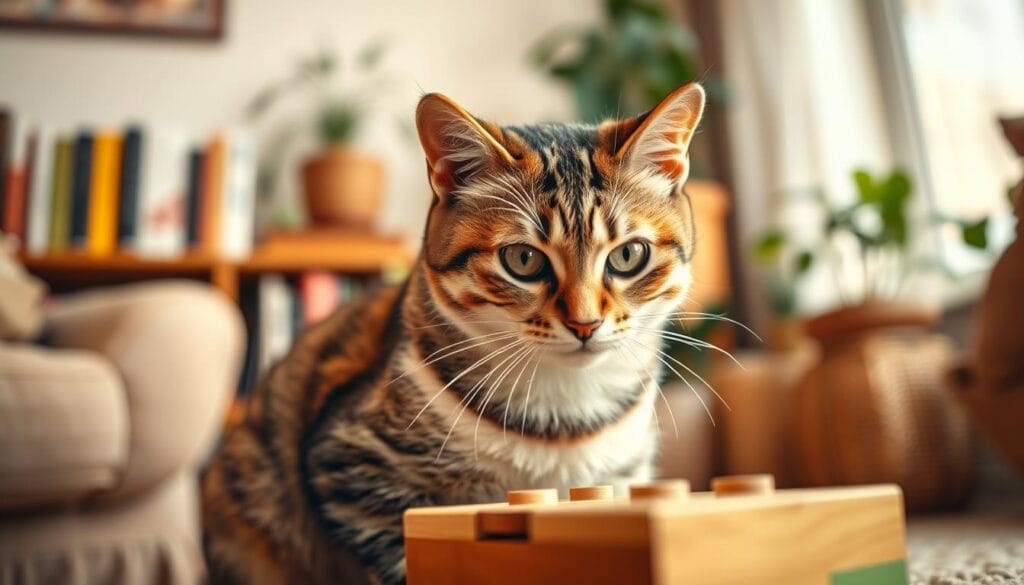
Understanding cat socialization is key to boosting your cat’s brain power. Feline social smarts help them deal with their world and solve tough problems. Early life experiences shape their ability to face challenges and talk to others.
Studies show that well-socialized cats are super at solving problems. When humans interact with cats during important times, it makes them smarter. Kittens that try new things grow up to be more flexible and curious.
- Early socialization improves cognitive flexibility
- Positive interactions boost problem-solving skills
- Regular engagement enhances mental stimulation
How you socialize your cat is important. Gentle, consistent interactions create a foundation for learning. Meeting new people, sounds, and places helps their brain grow and makes them braver to try new things.
Socialization is not just about exposure, but about creating positive, enriching experiences that expand your cat’s understanding of the world.
Effective cat socialization strategies include:
- Introducing novel experiences gradually
- Using positive reinforcement techniques
- Creating safe, controlled environments for exploration
By spending time on your cat’s social growth, you’re helping their brain reach its full potential. You’re also making your bond stronger.
Common Problem-Solving Challenges for Cats
Cats are amazing problem-solvers with unique skills. They show these skills every day. Knowing how they solve problems helps us support their minds and adapt to their surroundings.
Domestic cats face many challenges that test their smarts and creativity. These include figuring out complex food puzzle feeders and managing their territory.
Food Puzzle Navigation
Cat puzzle feeders are a fun mental challenge for cats. Studies reveal interesting facts about their problem-solving skills:
- 28% of cats successfully extract treats from puzzle boxes
- Younger cats typically demonstrate faster learning curves
- Complex puzzles engage cats’ natural hunting instincts
Door Opening Techniques
Cats find clever ways to get into places they shouldn’t. They use different methods, like:
- Pawing at door handles
- Jumping and pushing doors
- Observing and mimicking human opening movements
Territory Management
Cat territorial behavior is another complex skill. Cats carefully manage their space to keep it their own.
| Territorial Strategy | Problem-Solving Approach |
|---|---|
| Scent Marking | Communicating boundaries without direct confrontation |
| Vertical Space Exploration | Creating safe observation points |
| Strategic Hiding | Managing social interactions and perceived threats |
Understanding these challenges helps us create a better environment for our cats. It supports their brain growth and natural behaviors.
Environmental Enrichment for Mental Stimulation
Creating a stimulating cat environment is key for your cat’s mental health. Toys that challenge their minds are essential. They keep your cat sharp and engaged. By using smart enrichment techniques, you can turn your home into a fun playground for your cat.
Here are some important tips for enriching your cat’s mind:
- Introduce interactive puzzle feeders that require problem-solving skills
- Rotate toys to maintain novelty and prevent boredom
- Create vertical spaces like cat trees and shelves for exploration
- Use treat-dispensing toys that encourage mental engagement
Cats are natural hunters with complex minds. A good environment should let them hunt, climb, and explore. Puzzle toys that require manipulation to release treats can significantly improve your cat’s mental acuity.
Different toys can help with different skills:
- Hunting simulation toys
- Electronic interactive games
- Scent-based challenge toys
- Manipulative puzzle feeders
By focusing on enrichment, you’re doing more than just having fun with your cat. You’re helping their brain grow and preventing bad behavior.
Cat Problem Solving in Natural Settings
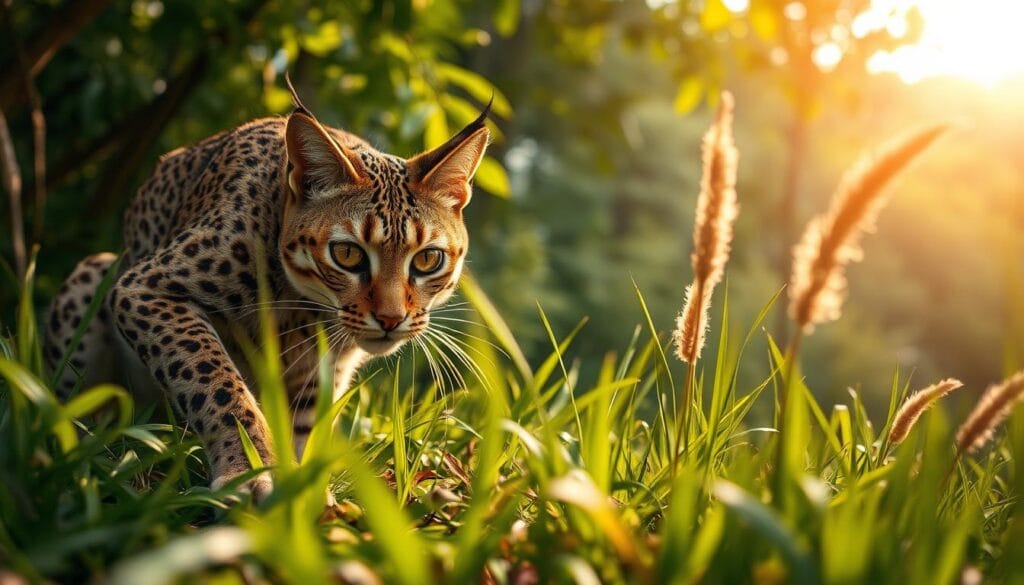
Wild cats show amazing problem-solving skills. These skills help them survive in tough environments. Your home cat has these skills too, even if it’s not as obvious.
Cats in the wild solve problems in complex ways. They make smart decisions to stay alive. Their skills include:
- Identifying potential prey locations
- Assessing environmental risks
- Creating strategic hunting approaches
- Adapting to changing terrain conditions
To understand cat problem-solving, we must see how they interact with their world. Cats use their senses to make important choices. They rely on:
- Acute hearing
- Superior night vision
- Sensitive whiskers for spatial awareness
- Sophisticated scent tracking
| Natural Skill | Survival Purpose | Key Adaptation |
|---|---|---|
| Stealth Movement | Hunting Prey | Silent Footsteps |
| Environmental Assessment | Predator Avoidance | Quick Threat Detection |
| Resource Location | Food and Water Finding | Strategic Exploration |
Your domestic cat still has these amazing abilities. Even though indoor settings are different, their core skills stay strong. Watching your cat can show you these ancient survival tactics.
The Impact of Domestication on Feline Intelligence
The journey of cat domestication has changed their brains a lot. When we compare wild and domestic cat brains, we learn a lot. This shows how cat brains have evolved over time.
Domestication has changed how cats solve problems. Wild cats mainly use their instincts to survive. But domestic cats have learned to solve problems in a more complex way because of humans.
Evolutionary Changes in Problem-Solving
Domestication has made cats smarter in many ways:
- They have smaller brains than their wild ancestors
- They learn from humans better
- They solve problems in a more clever way
- They understand humans better
Wild vs Domestic Cat Intelligence Differences
Domestic cats are smarter because of their long relationship with humans. They are different from wild cats in many ways:
- They are more emotionally smart
- They communicate in a more complex way
- They understand human gestures better
- They can trick humans in a clever way
These changes show how domestication has made cats smarter. It has helped them go from just surviving to being very social and smart.
Training Techniques to Enhance Problem-Solving
Improving your cat’s mind needs smart and fun training methods. Cats are smart and can solve problems well. They can get better at this with the right exercises.
Good cat exercises make their minds work and teach them in fun ways. You can boost your cat’s brain power with several methods:
- Clicker training to reinforce complex behaviors
- Interactive puzzle toys that reward problem-solving
- Treat-dispensing games that challenge spatial reasoning
- Obstacle course navigation
Playing with your cat regularly is key to their brain growth. Mental exhaustion can be just as satisfying as physical exercise for cats. By changing up the challenges, you keep them interested and curious.
Try to train your cat every day for 10-15 minutes. These short sessions keep them engaged and make the training more challenging.
“A mentally stimulated cat is a happy, well-adjusted companion.” – Feline Behavior Experts
Every cat learns in their own way. Be patient and use positive rewards to help them grow. Watch what your cat likes and make the exercises fit their learning style.
Signs of Advanced Problem-Solving Abilities
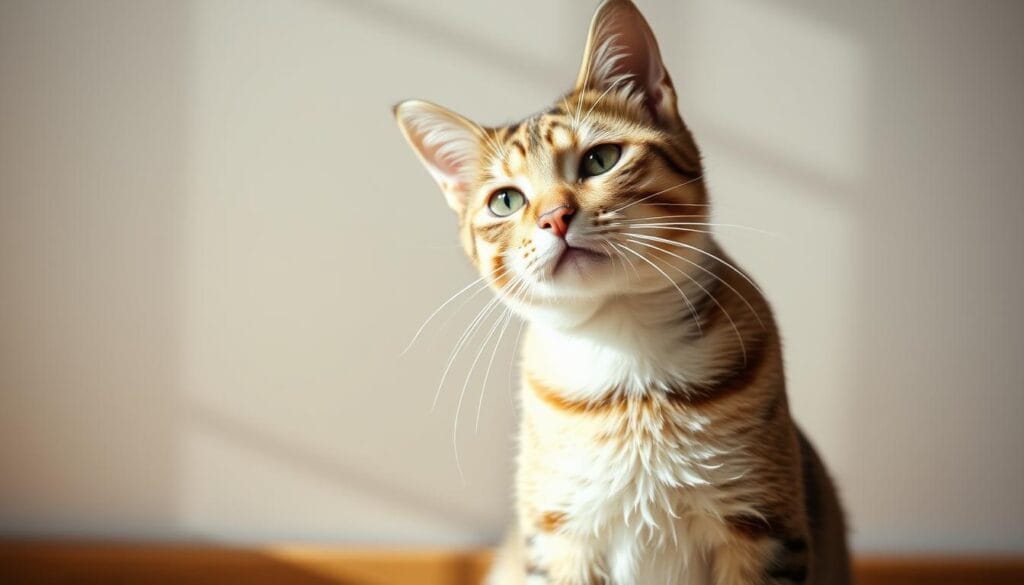
Seeing cat intelligence is more than just looking. Smart cat behavior shows us how clever they are. Cats can solve problems in amazing ways, surprising even the most seasoned pet owners.
Feline cognitive signs show up in certain behaviors. These behaviors show their advanced thinking. Look for these signs of top-notch problem-solving skills:
- Strategically manipulating objects to achieve a desired outcome
- Quickly learning complex sequences of actions
- Demonstrating creative approaches to challenges
- Showing persistent curiosity about their environment
Cats can develop surprisingly sophisticated problem-solving techniques that showcase their remarkable intelligence. For example, some cats learn to:
- Open cabinet doors with precise paw movements
- Navigate puzzle toys with remarkable speed
- Create innovative solutions to reach desired objects
“A cat’s mind is a complex maze of creativity and intelligence that continually challenges our understanding.” – Dr. Sarah Reynolds, Feline Behavior Specialist
Your cat’s advanced problem-solving depends on mental stimulation and a good environment. Toys, interactive play, and challenging settings help show their brain power.
Watch how your cat tackles challenges. Each cat shows intelligence in their own way. Their problem-solving journey is both interesting and unique.
Obstacles That Affect Problem-Solving Performance
Exploring cat stress and cognition shows us big barriers to problem-solving. Cats are very sensitive. Their minds can be greatly affected by their surroundings and feelings.
Environmental stress in cats can really mess with their thinking. Your cat’s ability to solve problems can be hurt by many things. These things make it hard for them to think clearly.
Primary Stress Factors
- Sudden changes in household routine
- Introduction of new pets or family members
- Loud noises or unexpected disturbances
- Limited personal space
Environmental Limitations
Problem-solving barriers come when cats don’t get enough mental challenge. They need places that make them think and explore.
- Insufficient interactive toys
- Monotonous living spaces
- Lack of vertical exploration areas
- Minimal social interaction
Knowing these obstacles helps you make a better space for your cat. This can improve their thinking and problem-solving skills.
Understanding your cat’s unique stress triggers is key to maintaining their mental sharpness and overall well-being.
Supporting Your Cat’s Cognitive Development
Keeping your cat’s brain healthy is more than just basic care. It’s about creating a stimulating environment. This helps challenge and improve your cat’s mental skills. By using the right strategies, you can boost your cat’s intelligence and keep their brain sharp.
Diet is key for your cat’s brain health. Here are some important nutrition tips:
- Incorporate omega-3 fatty acids for brain health
- Choose high-quality protein sources
- Provide antioxidant-rich foods
- Ensure proper hydration
Mental stimulation is also vital. Engage your cat with activities that test their problem-solving skills:
- Interactive puzzle feeders
- Rotating toy collections
- Training sessions with positive reinforcement
- Environmental enrichment with climbing structures
Regular vet visits are important for checking your cat’s brain health. Early detection of potential cognitive challenges allows for proactive intervention. Your vet can suggest specific supplements or strategies for your cat’s needs.
Mental exercise is as crucial for cats as physical activity. Keep your feline friend’s mind sharp and engaged!
By focusing on your cat’s mental growth, you’ll have a lively, active companion for years to come.
Conclusion
Understanding cat intelligence opens up a world of complex problem-solving. Your feline friend has amazing cognitive skills that go beyond simple instincts. They can learn, adapt, and solve problems with great precision.
Exploring feline problem-solving shows how smart cats really are. They use complex strategies to understand their world and solve daily challenges. Their brains are wired to think critically and come up with creative solutions.
As a cat owner, you’re key in helping your pet grow mentally. Give them engaging spaces, toys, and mental challenges. This unlocks their full potential and strengthens your bond.
Research into cat intelligence is ongoing, promising more insights into these amazing animals. By supporting your cat’s cognitive abilities, you can make pet care more rewarding for both of you.
FAQ
How intelligent are cats compared to other pets?
Cats are as smart as a 2-year-old human. They can solve complex problems. Their brains let them learn by watching and adapting to new places.
Can cats learn new skills as they age?
Yes, cats can keep learning new things. Even as they get older, they can still get better at solving problems. This is thanks to mental exercises and training.
How can I improve my cat’s problem-solving abilities?
To make your cat smarter, try using puzzle toys and climbing structures. Also, play with them regularly. This keeps their mind sharp and ready to learn.
Do indoor cats have different problem-solving skills than outdoor cats?
Indoor cats might not get to practice hunting. But, they can still learn and grow through play and training. It’s all about keeping their minds active.
At what age are cats most capable of learning?
Cats learn best when they’re young, between 2-7 weeks. They stay smart as adults if they keep getting mental challenges.
How do stress and environment impact a cat’s problem-solving abilities?
Stress and changes in their home can hurt a cat’s brain power. They need a stable, fun place to live to stay sharp.
Can cat puzzle toys really improve their intelligence?
Puzzle toys are great for a cat’s brain. They make cats think and learn. It’s a fun way to keep their minds active and prevent boredom.
How does socialization affect a cat’s problem-solving skills?
Socializing a cat early is key. It helps them learn and adapt. They become better at solving problems as they grow up.



